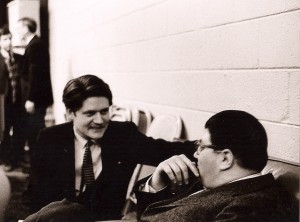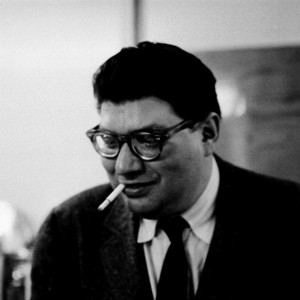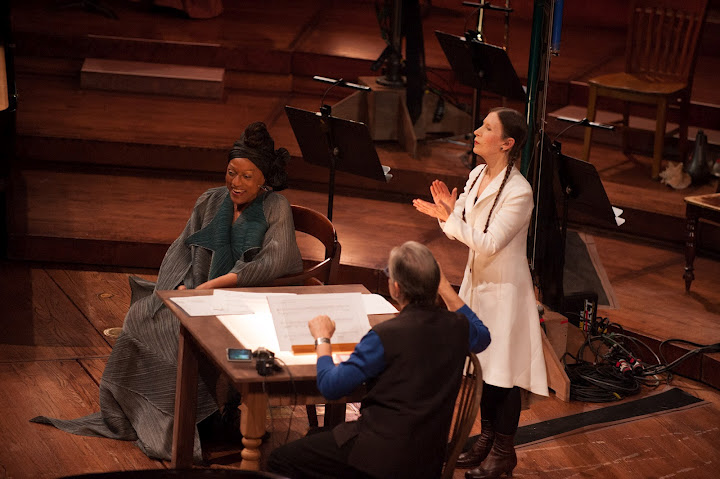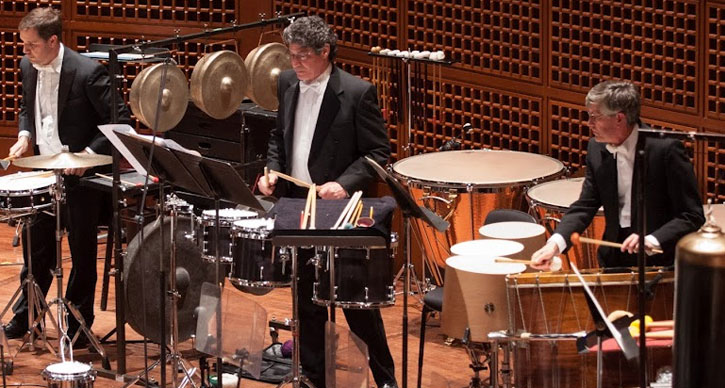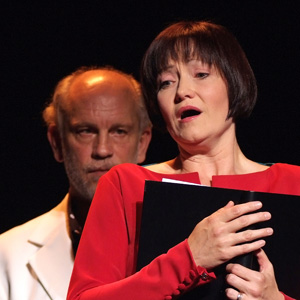Michael Tilson Thomas at 1988 UMS May Festival
We’re getting ready for another visit from San Francisco Symphony on November 13 and 14, 2014. This visit celebrates the 70th birthday of music director Michael Tilson Thomas, and we wanted to share two archival photos from another performance featuring conductor Michael Tilson Thomas, the 1988 UMS May Festival.
In this photo, the Pittsburgh Symphony performs at 1988 May Festival with Michael Tilson Thomas conducting.
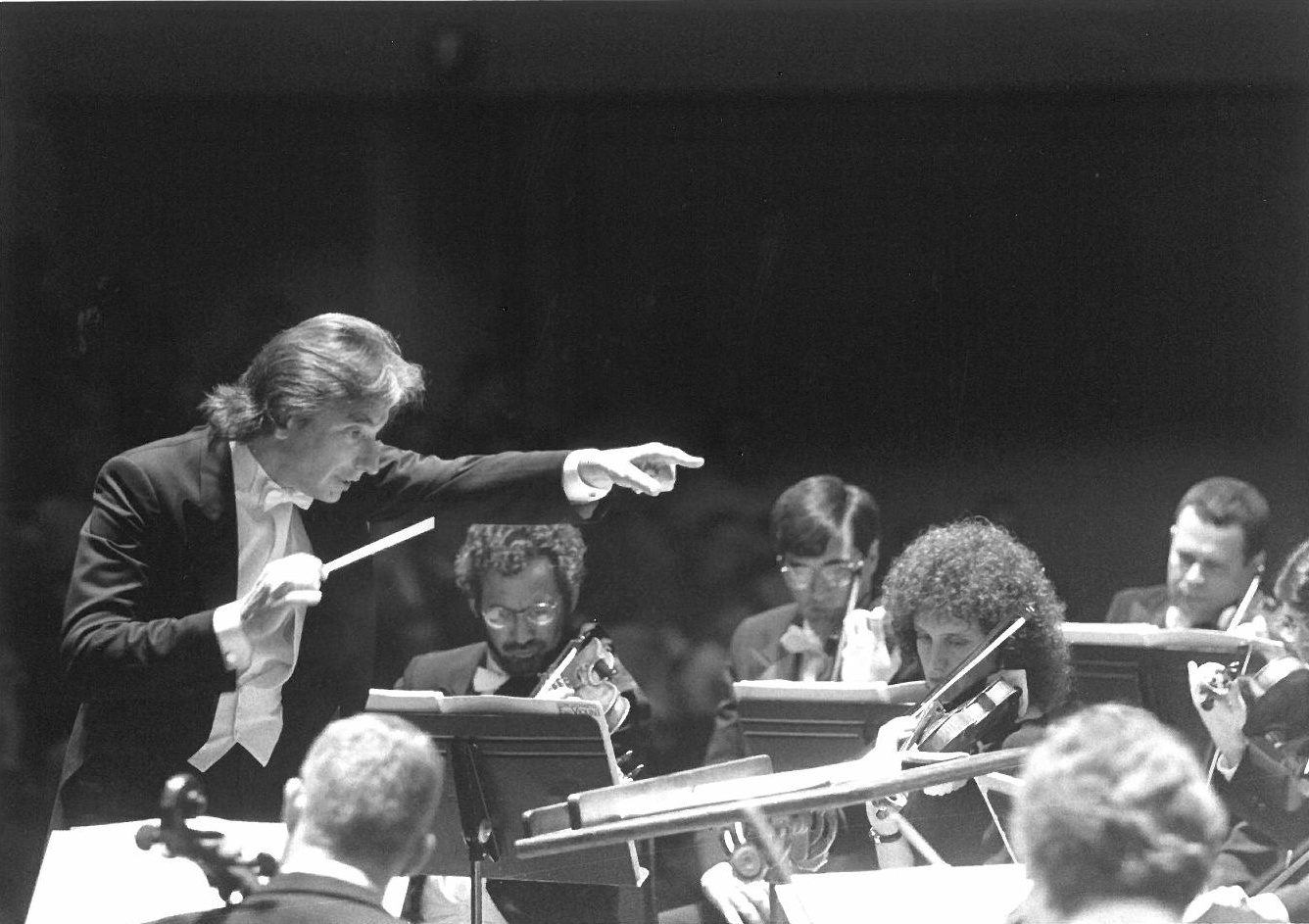
Michael Tilson Thomas signs autographs backstage in Hill Auditorium.
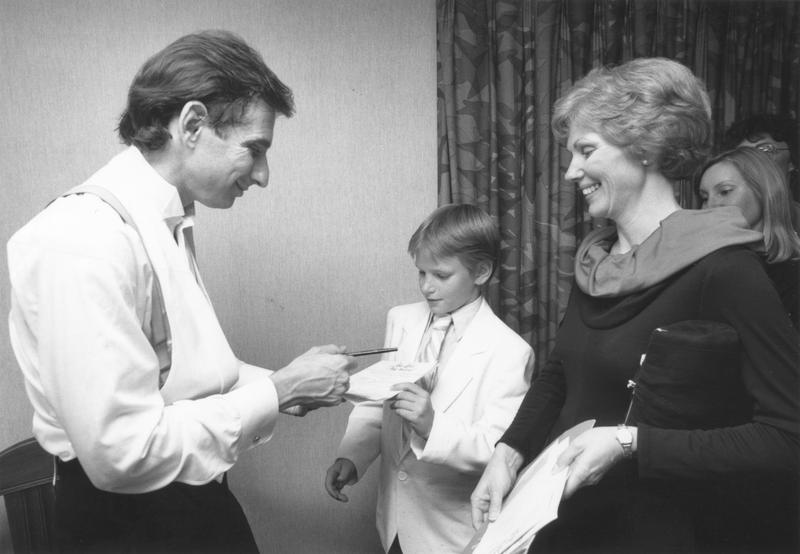
To learn more about the May Festival’s one-hundred year history, watch “A Space for Music, A Seat for Everyone,” our feature documentary about Hill Auditorium.
Interested in more from our archives? Check out our digital archives at umsrewind.org.
Student Spotlight: Embedded with San Francisco Symphony
Editor’s note: This summer, UMS launched a new 21st Century Artist Internships program. Four students interned for a minimum of five weeks with a dance, theater, or music ensemble part of our 2014-2015 season. Libby Seidner is one of these students. She spent five weeks with the San Francisco Symphony.
Below, Libby shares her travel stories with the orchestra in advance of their return two Ann Arbor on November 13 and November 14, 2014. They’ll perform two different programs.
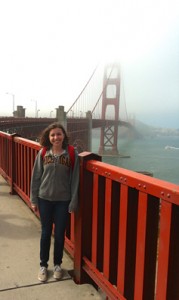
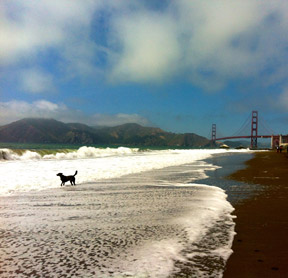
Photos: On left, a photo from my first time on the Golden Gate Bridge. Walking across the Bay to Sausalito was one of my favorite SF activities. On right, view from Baker Beach. All photos by Libby Seidner.
During my first week at the San Francisco Symphony artistic planning coordinator Jim Utz asked me, “You do realize that you’ve come to the busiest symphony orchestra?” I nodded and smiled, but I had no idea what I was in for. At 52 weeks, the SFS has one of the longest seasons of any symphony orchestra. Those 52 weeks are packed with recording projects, album releases, domestic and world tours, concerts for families, as well as fantastic series concerts at their home, Davies Symphony Hall, right in the heart of San Francisco. The Symphony employs 107 musicians and 140 staff.
Being a fly on the wall of this large non-profit organization was an unbelievable learning experience. As part of my internship, I worked on artist interviews, collected behind-the-scenes photos, managed education events, the Britten Festival, an album release, and more. For college students, finding opportunities to work with a symphony orchestra while in season is nearly impossible. The UMS 21st Century Artist Internship program provided me with the professional and education experience of a lifetime.
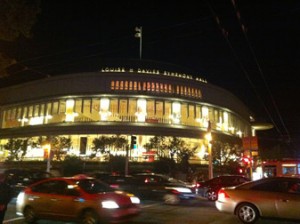
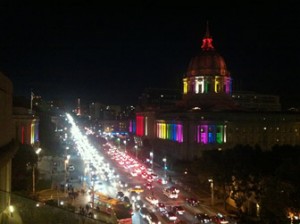
Photos: On left, Davies Symphony Hall at night from street level. The building was designed specifically to look open and inviting from the outside. On right, a view of city hall from the third floor balcony of Davies. It was amazing to see the entire city covered in rainbow to celebrate pride week.
One of my favorite components of the internship was interviewing SFS musicians. I got to know Symphony personnel while discussing repertoire, the upcoming tour, and the historic relationship between UMS and the SFS. Over the course of the interviews, I found myself feeling closer to the orchestra and more connected to the music they were making.
While attending concerts and listening in on rehearsals I had “friends” to listen for. For example, I got to know principal clarinetist Carey Bell, who studied undergraduate clarinet performance and composition at the University of Michigan School of Music, Theatre, and Dance. We bonded over shared experiences of Zingerman’s Deli, the practice rooms of the SMTD and the amazing Ann Arbor student community.
The experience of building these relationships taught me the importance of reciprocity between audience and artist. As an audience member, I am more engaged when I have context. Building relationships with orchestra members reduced the distance I often felt as a listener. I hope to build this bridge for UMS audiences.
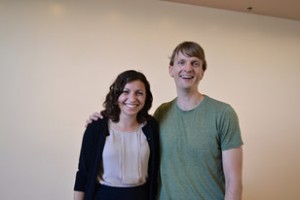
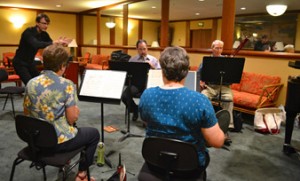
Photos: On left, SFS principal clarinetist Carey Bell and me after our video interview. Carey received his bachelor’s degree at the University of Michigan, studying clarinet performance and composition. On right, Carey Bell coaches a chamber group of local amateur musicians during the Community of Music Makers event.
UMS and the SFS are organizations that work well together because of their shared commitment to access and innovation. Both are looking to provide the best arts experience to as many different people as possible. While I was at the SFS, development of a new series called “Soundbox” was underway. This future concert series will take place in a smaller hall and be directed towards a younger and more diverse audience. The concerts will feature new music and have a host who’ll share insights into the performance.
Similarly, UMS encourages college students and community members to get involved in the arts through programs like U-M classes about the performances, educational electronic media, half-price student tickets, and internship opportunities. These organizations inspire me to think broadly about arts institutions as community organizers. What is the role and responsibility of an arts organization in the community?
One such inspiring SFS initiative that engages reciprocally with the community is the Community of Music Makers program, led by Lolly Lewis of the education department. These events brings local amateur musicians into Davies Symphony Hall to be coached by Symphony musicians and conductors. At the end of a day of hard work and rehearsals, the local musicians have a chance to perform on the Davies Symphony Hall stage.
The performance is the most beautiful part of the event.The musicians perform for each other and a few close friends and family members. The intimacy of the small performance makes the giant hall seem less intimidating and foreign. The idea is to open up the private stage into a public place for genuine civic activity. Not only do the amateur musicians tend to become more engaged audience members and supporters of the SFS, but the Symphony musicians have had a rare chance to meet their audience. The Community of Music Makers program serves as a superlative model for community arts engagement.
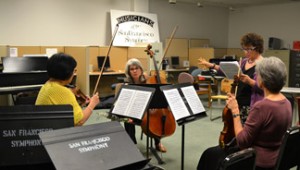
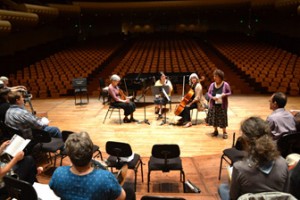
Photos: On left, a local amateur string trio coached by SFS cellist Barbara Bogatin during the Community of Music Makers event. On right, after several hours of coaching, the ensembles perform for one another on the stage of Davies Symphony Hall.
In addition to connecting with the Bay Area community, the Symphony reaches a half a million listeners every year through domestic and world tours, weekly radio broadcasts, and media sales. My internship lined up with the release of the SFS’s recording of West Side Story. This live recording is the first-ever complete concert performance of Leonard Bernstein’s original score.
Having the chance to see what’s involved in a major recording release was an incredible experience. Although many of the media meetings that I sat in on were over my head, the energy surrounding the album release in those weeks was palpable—holding the CDs before they became publically available was thrilling.
The release culminated with a party at the top floor of Twitter headquarters on Market Street. Here, I got to see Michael Tilson Thomas and the stars of the recording up close, as well as hear performances of “Maria” by Cheyenne Jackson (Tony) and “I Feel Pretty” by Alexandra Silber (Maria). #IFeelPretty #SFSWSS #TonightTonight!
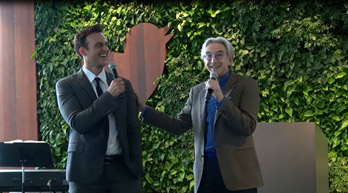
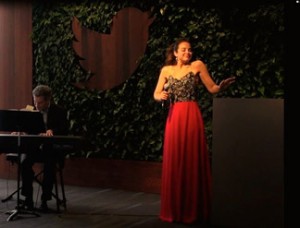
Photos: On left, Cheyenne Jackson and Michael Tilson Thomas at the West Side Story album release party in the Twitter building. Mr. Jackson sings the role of Tony on the album. On right, Alexandra Silber performs “I Feel Pretty” at the West Side Story album release party in the Twitter building. Ms. Silber sings the role of Maria on the album.
My internship also lined up with an SFS series concert featuring international violin soloist Gil Shaham (who’ll also perform in Ann Arbor in November!). Mr. Shaham and the SFS have had over 26 performance engagements together, and the violinist also has strong ties to Ann Arbor, having commissioned and premiered several pieces by U- M composition faculty, including William Bolcom and Bright Sheng.
I was very excited to hear Gil Shaham and the SFS play but never imagined that I would meet him. When I proposed the idea of video interviewing Gil Shaham about Ann Arbor and the upcoming tour, I expected the answer “no.” However, I was surprised and delighted that Mr. Shaham was happy to talk to me!
Meeting Gil Shaham was one of the major highlights of my internship. His extreme musical talent is matched only by his warm personality and approachability. We shared stories of Ann Arbor, performing in Hill Auditorium, the San Francisco Symphony, and UMS. Needless to say, the Ann Arbor music community is very much looking forward to the reunion and return of these artists to the stage of Hill Auditorium this November!
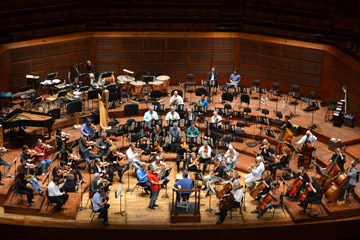
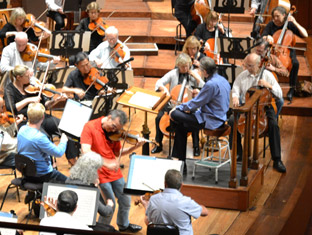
Photos: On left and right, the Symphony rehearses Prokofiev’s Violin Concerto No. 2 with Gil Shaham.
The Symphony’s support in this project was a testament to the character of everyone involved at the SFS. Although I was an intern, not very high up on the food chain, no one treated me that way. Whenever I had an idea or request, I was provided with the resources. I am so grateful to have had the chance to work at such a giving organization.
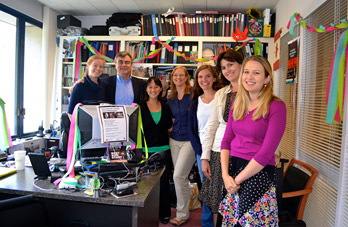
Photo: Several members of the Operations Department celebrate General Manager John Kieser’s birthday. From left to right: Andrea Drummond, John Kieser, Jeannette Wong, Joyce Wessling, Casey Daliyo, Nicole Zucca, and Jessica Huntsman.
Excellence and innovation were terms that I heard frequently around the Symphony office, referring to the talent on stage and off. A world-class orchestra, elite administration, and excellent people, make the San Francisco Symphony so incredibly successful as an international arts leader, a community organizer, and an orchestra. I had an amazing summer working with the best symphony orchestra in the best city. As the song goes, “I left my heart in San Francisco.”
Interested in more? Check out San Francisco Symphony through our archives.
The Lives of Men – Guest Blog by Leslie Stainton
Photos from the UMS Archive. 1. L-R: Gordon Mumma with visiting composer Morton Feldman, ONCE Festival (1964), Ann Arbor. (Photo: Donald Scavarda) 2. Morton Feldman in Ann Arbor, ONCE Festival (1964). (Photo: Makepeace Tsao, courtesy of the Tsao Family)
Editor’s Note: Lobby contributor Leslie Stainton will guest blog the San Francisco Symphony American Mavericks festival throughout this weekend. Read her notes on Friday and Saturday.
Biography kept popping up. From Saturday’s pre-concert presentation on Charles Ives and his Concord Sonata, to the intros to each of the evening’s pieces, to the final, riveting and mercurial Concord Symphony, character and personality held center-stage throughout last night’s program. I’ve devoted huge parts of my life to writing and reading biography, so I generally don’t need convincing, but I found myself wondering at times last night whether it makes a difference to know, for example, that Carl Ruggles hated Brahms and destroyed much of his own work, or that Morton Feldman was a friend of Mark Rothko. In the end, I think it does.
Before each of the three pieces on Saturday’s program, Michael Tilson Thomas spoke briefly, and fondly, about its composer. Of the difficult and “craggy” Carl Ruggles, whose “Sun-treader” (1931) opened the evening, MTT said, “He spent most of his life pent-up in a small, one-room schoolhouse in Vermont with a piano a pot-bellied stove, and his adoring wife.” On weekends, Ruggles was visited by the likes of Thomas Hart Benton (who used the composer as a model for Ahab in his illustrated “Moby Dick”). Ruggles produced a slender oeuvre—just a dozen or so works—and they’re filled with defiance, rage, deep sorrow, and an aching passion, MTT said. “You instantly know it’s a statement by Carl Ruggles. So get ready.”
And he was right. With its huge and sober sounds, beautiful and raging all at once, “Sun-treader” seemed to me a palpable cry. I kept thinking of Icarus, striding toward the sun in his doomed chariot. And of Ruggles himself—a man who denounced the mainstream, an outlier unafraid of gods.
If Ruggles was a small man who wrote big, MTT said by way of introduction to the second work on the program, Morton Feldman was a big man who wrote delicate music. And then MTT launched into a brief imitation of Feldman—put on your best Brooklyn accent, and you’ve got it. “Dis work is de classiest ting Ay eva wrote,” Feldman (in MTT’s version) might have said about his “Piano and Orchestra” (1931), which MTT described as a cross between Webern and Duke Ellington. Elegant it was, as subtle and moving as a Rothko canvas (to which both MTT and the program notes likened Feldman’s work—MTT noting that “time” was Feldman’s “canvas”).
At one point during this languid piece, I felt as if I were hearing a deeply sophisticated “Peter and the Wolf,” so magically did the work illuminate each instrument in the orchestra, allowing us to focus on color and tone rather than the usual culprits, melody and rhythm. (Is it stretching things to suggest this functioned at least in part as a “biography” of an orchestra?)
Biography returned full-force in Charles Ives’s “Concord Symphony,” the last work on Saturday’s program, with its four sections devoted to four men who inhabited the legendary town where the American Revolution erupted—Emerson, Hawthorne, Alcott, Thoreau. MTT described the symphony as an epic, and it was. Big, bracing, with sudden and exquisite moments of tenderness nestled among passages of utter fury. I’ve always liked Ives, the Connecticut iconoclast who made his living selling insurance and persisted in writing works that few wanted to hear. But this piece brought him to life in ways I hadn’t heard before—and underscored the majesty and “Americanness” of his often nostalgic vision. A woman I spoke to after the performance summed it up: “This felt almost classical,” she said—especially after Friday night’s foray into the world of John Cage.
I do have one question about biography—where are the women in this series?
During intermission, I cornered the American composer and U-M faculty member Michael Daugherty, who was sitting a few rows in front of me, and asked him what these concerts meant to him:
Word has it that Carnegie Hall is having a tougher time filling its house for these concerts next week than Hill (a larger hall in a far smaller community). It’s a credit to Ann Arbor audiences, as Daugherty reminded me:
Cat Calls, Cheers, and the Glories of Sound – Guest Blog by Leslie Stainton
Photo: From left to right: Jessye Norman, Michael Tilson Thomas and Meredith Monk perform in John Cage’s Song Books during the San Francisco Symphony’s American Mavericks Festival at Davies Symphony Hall in SF on March 10. Photo credit: Kristen Loken.
Editor’s Note: Lobby contributor Leslie Stainton will guest blog the San Francisco Symphony American Mavericks festival throughout this weekend. Her first post is here.
The ride—we’ve definitely moved from journey to ride—continued on Friday night with a rollicking three-hour Mavericks program that included a witty tribute to Beethoven, a tempestuous plunge into the pleasures of sirens and things that go thwack, a surprisingly lyrical piece by the same Henry Cowell who’d shattered any peace on Thursday night, and the evening’s most talked-about event—a gloriously funny, straight-from-the-Sixties, half-hour spectacle by John Cage, featuring Jessye Norman, Meredith Monk, Joan La Barbara, and Michael Tilson Thomas. The latter showed off his prowess at the blender by whipping up a smoothie. (Recipe not included.)
Here’s what Bob Wallin, who sat behind me (and is no musical slouch, being a season ticketholder at UMS, Lyric Opera, and Michigan Opera Theater), had to say about it:
Wallin wasn’t alone. When the lights fell on the last of Cage’s mania, someone in the audience began booing. It’s the first time anyone I spoke to can remember a boo in Hill Auditorium. Was he a plant? UMS’s marketing director Sara Billmann swears not, as does San Francisco Symphony’s Susan Key. So here’s my challenge: will the real booer please come forward?
Out in the lobby during intermission, I encountered Garrett Schumann, a composition student at U-M, who thought it was all great fun. He especially liked it that audience members literally stood up to the booer with cheers, thunderous applause, and a standing ovation. Here’s Schumann’s take:
I later ran into a former music buyer for Borders who felt much the same. “I mean, you come to a John Cage concert, what do you expect? It’s not as if this is 1913.”
Whatever else you thought of the Cage piece—which had to have cost a small fortune, by the way, given all the personnel and technology assembled onstage—it was a hoot to be there. A Happening in 2012 in staid Hill Auditorium? Worth every excruciating minute.
The second half of the program—Henry Cowell’s riveting “Synchrony,” with its gorgeous trumpet solo; John Adams’s aptly named “Absolute Jest,” whose opening strains made hay with Beethoven’s 9th; and Edgard Varèse’s pounding “Amériques,” with no fewer than 12 percussionists and a massive brass section—had me wanting to shout with glee as I left Hill. All through the evening, I kept thinking about sound: what we hear when we’re not really listening, how beautiful something as chilling as a siren can be, how innately musical noise is, how many magnificent and bizarre and thrilling and offputting ways humans have managed to create sound. A bass drum suspended 12 feet in the air, a bassoon played with a violin bow, a heckelphone—who knew?
By the end of the evening, even my seatmate Bob Wallin had forgotten Cage:
First “Mavericks” – Guest Blog by Leslie Stainton
Photo: The SFS percussion performing in Lou Harrison’s Concerto for Organ and Percussion Orchestra as part of the Opening Concert of the American Mavericks Festival in San Francisco. (l-r James Lee Wyatt, Artie Storch, Tom Hemphill) Credit: Kristen Loken.
Editor’s Note: Lobby contributor Leslie Stainton will guest blog the San Francisco Symphony American Mavericks festival throughout this weekend.
For starters, there was the matter of dress: instead of 19th-century penguin suits, the men in the SF Symphony’s opening American Mavericks concert last night wore casual black pants and open-collared black shirts. You could feel their pleasure. That pleasure turned into radiant joy as the evening progressed, and the musicians worked their way through the bracing, at times tempestuous, at times haunting music of Copland, Cowell, Lou Harrison, and the young, Philadelphia-born Mason Bates, who performed onstage in his own evocative “Mass Transmission,” which had its world premiere last week in San Francisco.
Even if you think you hate this stuff—and for those who chafe at dissonance, there was plenty to hate—last night’s concert was a marvel. If only for the chance to see oxygen tanks take a percussive pounding center-stage. If only for the chance to hear Hill’s glorious organ get a workout the likes of which might have made Bach’s jaw drop. If only for the sheer delight of watching pianist Jeremy Denk slam his body into a Steinway again and again and come up beaming.
If only for the brief and almost gossipy talks Michael Tilson Thomas gave before each work on the program. Thomas not only knows these pieces but knew the composers and told stories about each, so as you listened to the works you could picture old Henry Cowell hanging out with an Irish cult in the woods north of San Francisco or Lou Harrison proudly driving one of the Bay Area’s first cars to run on leftover restaurant grease.
A few highlights:
7:17 pm
As the orchestra tunes up onstage—no happy trills here, but rather discordant tones, squeaks, mournful bleats—I read with admiration a short program note by co-sponsor Maxine Frankel, who says she and her husband helped fund these concerts to ensure that UMS “has the flexibility to consider the new, the different, the innovative, and the cutting-edge.” In a country whose public schools are slashing arts education, we desperately need this kind of thinking. Thank you, Frankels.
7:35 pm
Michael Tilson Thomas takes the stage. “What does it mean to be a maverick?” he asks. The next four nights will help shape answers.
7:48 pm
Midway through Copland’s “Orchestral Variations,” percussionists are snapping their fingers. My husband and I look at each other and grin. “This is so refreshing,” he says to me later. “The array of different sounds.”
7:55 pm
Introducing Henry Cowell’s “Piano Concerto,” MTT (as orchestra members call him) speaks of the composer as a Bay Area “maverist” famous for “vast splodges of notes.” Thomas says we can expect to hear traces of Cowell’s prodigious knowledge as an ethnomusicologist—and we do.
7:58 pm
The opening notes of Cowell’s concerto sound like cars in traffic. But then: surprising beauty. I feel for a moment as if I’m at a cocktail party with someone rippling the piano in the background. Jeremy Denk’s face is a wonder: he grimaces, shakes his jowels, heaves his body into the keyboard.
8:06 pm
The piano as machine gun.
8:10 pm
Denk convulses. He’s playing impossibly fast. Chopsticks on speed.
8:14 pm
Utter cacophony suddenly and bewilderingly culminates in an almost kitschy Hollywood ending. We’re done. The audience erupts. My friend Jim Kister, who’s sitting two rows in front of us, and whose musical tastes run to the conventional, takes his time applauding. During intermission I ask him what he thought:
8:28 pm
I ask one of the ushers how she liked the first half. “It’s unique,” she says, tight-lipped. And then: “I’m anxious to see what they do with the oxygen tanks.” She means the string of big tanks parked downstage left, which have yet to be used. There are also big wooden drums, suspended gongs, chimes, a celesta.
8:40 pm
The U-M Chamber Choir takes the stage for Mason Bates’s “Mass Transmission.” Shouts of recognition from friends in the crowd. Bates himself looks like a college kid—skinny, dressed in a pullover and jeans, I think. He’ll function like a DJ on what he calls “electronica”—digital samplings and techno beats.
8:57 pm
This piece is gorgeous. Consonant, accessible. “Maverick” doesn’t have to be ugly, I realize. I didn’t expect to be moved to tears tonight, but Bates achieves it with his lyrical rumination on communication, technology, and the love between a mother and her daughter. Earlier he’s described this piece, about one of the world’s first long-distance communications initiatives, as “basically a story of skyping in 1920.”
9:04 pm
An ethereal ending—tones just drift off, and we’re left to contemplate the (presumably now-dead) real-life mother and child at the heart of this piece, and the way we live today vs. the miracle of this kind of communication nearly a century ago. How clever of Bates to use new technology to simulate and suggest the old. And through it all, the power of the human voice (which Bates says represents “the most beautiful animal warmth we have.”)
9:11 pm
MTT introduces the last piece, Lou Harrison’s “Concerto for Organ with Percussion Orchestra.” The stage is stripped away—just the organ and an array of often bizarre instruments (rasps, rattles, plumber’s pipes …). I’m reminded of the friend who refers to the percussion section as “the toy department.” MTT says, “This concerto represents Harrison’s extraordinary view of the musical world.” It’s got the rhythmic drive of the gamelan, of Africa, hints of 12-tone music, Middle Eastern vocal traditions.
9:20 pm
I’m hearing echoes of “Einstein on the Beach” in the organ’s runs. UMS has truly bookended its Renegade series.
9:25 pm
Medieval sounds. Beauty I didn’t expect.
9:31 pm
More echoes of “Einstein.” Was Glass a disciple of Harrison?
9:40 pm
A rousing evenings ends in a burst of percussive battering that folds into the eloquent ring of a suspended gong. Long fade to silence, and then again, the audience is on its feet. Earlier another friend I’d spotted in the audience told me, “I had a cup of coffee beforehand, because I thought I might have trouble staying awake, but it’s the last thing I needed.
Afterward, I run into Mona DeQuis and a colleague from the DSO shop, who are selling CDs in the lobby. We talk about the evening’s music:
Livestream Event with San Francisco Symphony
Join us Sunday, March 11 at 4 pm EST for a live web chat with mavericks Jeremy Denk and Morton Subotnick who will offer insights into the music featured in the American Mavericks festival. Submit your questions and chat with others online.
Stream: http://www.sfcv.org/mavericks
Did you miss it? Is it still a few days away? Check out our Maverick Mondays video series in the meantime.
11/12 Choral Union Series
Within the signature Choral Union Series, UMS presents 10 concerts in historic Hill Auditorium:
Subscription packages go on sale to the general public on Monday, May 9, and will be available through Friday, September 17. Current subscribers will receive renewal packets in early May and may renew their series upon receipt of the packet. Tickets to individual events will go on sale to the general public on Monday, August 22 (via www.ums.org) and Wednesday, August 24 (in person and by phone). Not sure if you’re on our mailing list? Click here to update your mailing address to be sure you’ll receive a brochure.
John Malkovich in The Infernal Comedy: Confessions of a Serial Killer
with The Vienna Academy Orchestra
and sopranos Valerie Vinzant and Louise Fribo
Martin Haselböck, conductor
Saturday, October 1, 8pm
John Malkovich makes his UMS debut as a dead serial killer who returns to the stage to present his autobiography in a public reading. Malkovich appears as part of a theatrical opera of sorts that features a 40-piece chamber orchestra and two sopranos telling the real-life story of Jack Unterweger, a convicted murderer and acclaimed prison poet who had been pardoned by the Austrian president Kurt Waldheim in 1990 at the behest of Viennese literati. This gripping performance uses arias and music by Gluck, Vivaldi, Mozart, Beethoven, Boccherini, and Haydn as the counterpoint to Malkovich’s emotional monologue, which shifts between reality and delusion.
Yuja Wang, piano
Sunday, October 9, 4pm
Twenty-four-year-old Chinese pianist Yuja Wang is widely recognized for playing that combines the spontaneity and fearless imagination of youth with the discipline and precision of a mature artist. She made her UMS debut in January 2008, just months after graduating from the Curtis Institute of Music, and since then has spent each year criss-crossing the globe with a cavalcade of impressive debuts and awards, including the prestigious Avery Fisher Career Grant, given to select musicians destined for bright solo careers.
Program
Ravel | Miroirs
Copland | Piano Variations
Rachmaninoff | Selected Preludes
Brahms | Sonata No. 1 or No. 3
Apollo’s Fire with Philippe Jaroussky, countertenor
Jeannette Sorrell, music director
Thursday, November 3, 8pm
UMS is delighted to welcome French countertenor Philippe Jaroussky in his UMS debut for this performance with Apollo’s Fire, “one of the nation’s leading baroque orchestras.” (Boston Globe) Named for the classical god of music and the sun, Apollo’s Fire was founded in 1992 by the young harpsichordist and conductor Jeannette Sorrell, who envisioned an ensemble dedicated to the baroque ideal that music should evoke various passions in its listeners. Together they explore the full dramatic range of Handel and Vivaldi’s arias for the virtuoso castrato singers of the 18th century.
Program
Handel | “Disperato il mar turbato” from Oreste
Handel | “Con l’ali di costanza” from Ariodante
Vivaldi | Concerto for Four Violins in b minor
Vivaldi | “Se in ogni guardo” from Orlando Finto Pazzo
Vivaldi | “Se mai senti spirati sul volto” from Catone in Utica
Vivaldi/Sorrell | La Folia (“Madness”)
Vivaldi | “Vedro con mio diletto” from Giustino
Vivaldi | “Nel profondo” from Orlando Furioso
London Philharmonic Orchestra
Vladimir Jurowski, conductor
Janine Jansen, violin
Tuesday, December 6, 8pm
The London Philharmonic returns for its first appearance since November 2006, this time under the direction of the exciting young conductor Vladimir Jurowski, who became the orchestra’s principal conductor in 2007, succeeding Kurt Masur. Janine Jansen, a 23-year-old violinist who has been a huge star in her native Holland ever since her Concertgebouw debut at the age of 10, makes her UMS debut as violin soloist.
Program
Pintscher | Towards Osiris (2005)
Mozart | Violin Concerto No. 5 in A Major, K. 219 (1775)
Tchaikovsky | Manfred Symphony, Op. 58 (1885)
From the Canyon to the Stars
Hamburg State Symphony
Jeffrey Tate, conductor
Francesco Tristano, piano
Daniel Landau, filmmaker
Sunday, January 29, 4pm
In 1971, Alice Tully, a New York performer and philanthropist who contributed toward the construction of the chamber music hall in Lincoln Center that bears her name, commissioned the French composer Olivier Messiaen to write a piece commemorating America’s Bicentennial. Messiaen was inspired and fascinated by the natural wonder he found in the landscapes of the American West. Des canyons aux étoiles represents Messiaen’s sonic impressions of America’s last untouched frontier.
Program
Messiaen | Des canyons aux étoiles
Chicago Symphony Orchestra
Riccardo Muti, conductor
Pinchas Zukerman, violin
Friday, March 9, 8pm
Riccardo Muti, the Chicago Symphony’s new music director, makes his first UMS appearance in 6 years, conducting an all-Brahms program. Violinist Pinchas Zukerman, recognized as a phenomenon for nearly four decades, returns to UMS for a performance of the Brahms Violin Concerto.
Program
Brahms | Violin Concerto in D Major, Op. 77
Brahms | Symphony No. 2 in D Major, Op. 73
Denis Matsuev, piano
Thursday, March 15, 8pm
Anyone who attended last season’s concert by the Mariinsky Orchestra came away talking about one thing: the astonishing piano soloist Denis Matsuev, whose extraordinary performance of Rachmaninoff’s Third Piano Concerto had the audience buzzing in the lobby at intermission, immediately after the performance, and for weeks beyond the concert hall.
Program
Tchaikovsky | Seasons, Op. 37a
Rachmaninoff | Prelude in g minor, Op. 23, No. 5
Rachmaninoff | Prelude in g-sharp minor, Op. 32, No. 12
Rachmaninoff | Étude-Tableaux, Op. 39, No. 6
Scriabin | Etude in c-sharp minor, Op. 2, No. 1
Scriabin | Etude in d-sharp minor, Op. 8, No. 12
Tchaikovsky | Dumka (Russian Rustic Scene), Op. 59
Stravinsky | Three Movements from Petrouchka
American Mavericks
San Francisco Symphony
Michael Tilson Thomas, conductor
Featuring: Emanuel Ax, piano
St. Lawrence String Quartet
Jessye Norman, soprano, Meredith Monk, vocals, and Joan La Barbara, vocals
Jeremy Denk, piano
Paul Jacobs, organ
Thursday, March 22 – Saturday, March 24
As part of its centennial season, Michael Tilson Thomas and the San Francisco Symphony will present its second American Mavericks Festival in March 2012, which will tour to only two venues in the US: Hill Auditorium and Carnegie Hall. The 2012 festival celebrates the creative pioneering spirit and the composers who created a new American musical voice for the 20th century and beyond. Choral Union Subscribers may choose two of the three concerts on the series.
Program 1 (Thurs 3/22, 7:30p)
Paul Jacobs, organ
Jeremy Denk, piano
Aaron Copland | Orchestral Variations (1930, orchestrated in 1957)
Henry Cowell | Piano Concerto (1928)
Mason Bates | Mass Transmission (2010)
Lou Harrison | Concerto for Organ with Percussion Orchestra
Program 2 (Fri 3/23, 8pm)
Jessye Norman, soprano
Meredith Monk, vocalist
Joan La Barbara, vocalist
St. Lawrence String Quartet
Henry Cowell | Synchrony
John Adams | Absolute Jest (2011)
John Cage | John Cage Songbooks (1970)
Edgard Varese | Amériques
Program 3 (Sat 3/24, 8pm)
Emanuel Ax, piano
Carl Ruggles | Sun-Treader
Morton Feldman | Piano and Orchestra (1975)
Ives | A Concord Symphony
Academy of St. Martin-in-the-Fields
Joshua Bell, director and violinist
Sunday, April 22, 4pm
Formed from a group of leading London musicians and working without a conductor, the Academy gave its first performance in its namesake church in November 1959. For their first UMS appearance in 11 years, the Academy brings their highly lauded sound to an exquisite all-Beethoven program. Superstar violinist Joshua Bell attacks the stunning Beethoven Concerto with his breathtaking virtuosity and sumptuous tone and leads the rest of the program from the concertmaster’s chair.
Program
Beethoven | Coriolan Overture, Op. 62
Beethoven | Concerto for Violin in D Major, Op. 62
Beethoven | Symphony No. 7 in A Major, Op. 92
Return to the complete chronological list.


